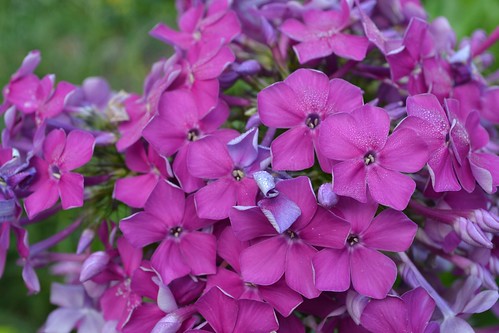Gardening is a fun, engaging activity that has many benefits for young children. You and your kids can learn about all kinds of plants that grow in Illinois, design a beautiful space to play in, and even grow food to cook together! Building a garden gives your children time outside while they help you plant seeds, weed, and water your plants.
One essential part of gardening is knowing which plants will grow best in your area. You’ll want to consider factors like your weather and soil as well as how much sun your garden will be getting. Some plants need a lot of sun, while others need more shade. In general, if you want to keep your kids entertained and interested in gardening, it’s important to focus on low-maintenance plants that they can take care of easily. Here are some of the best plants to include in your low-maintenance garden.
Garden Phlox

Image via Flickr by Gary Lerude
Garden phlox is a beautiful pollinator-attracting flower that’s native to the eastern and central United States. This flower comes in every color imaginable and blooms between July and September. Their blooms are clustered into a pillowy ball, and they can grow between 1 and 5 feet tall, depending on the variety. You and your little ones should plant these in a sunny spot, though they do grow well in some shade. They like moist soil, so be sure to water them near the ground, especially during dry spells.
You can plant garden phlox from pots starting in spring. When you plant them, space them out about 18 to 24 inches apart. You can also start them from seeds during late winter using fluorescent lights, which could be a fun indoor activity to help your kids get ready for spring gardening. While they’re growing, watch their leaves closely. If they become twisted and brown, this could be a sign that they have a powdery mildew infection, and you’ll want to get an organic antifungal to help get rid of the problem.
Black-Eyed Susan
Your kids will love the bright, sunny color these hearty wildflowers will bring to your garden! Black-eyed Susans are native to North America and grow well in both full and partial sun. Plant them between March and May for them to bloom between June and October. While Black-eyed Susans can grow in drier conditions, they prefer moist, fertile soil, so you should water them regularly. These are also susceptible to powdery mildew, so keep an eye out for the leaves turning brown.
These flowers typically grow up to 3 feet tall and can cover a lot of ground, so you will want to plant the seeds close together if you don’t want them to spread too far. You won’t need to reseed them after the first growing season because they attract pollinators like bees and butterflies! They are deer-resistant, but you might find other pests like aphids, snails, and slugs nearby. There are several varieties of Black-eyed Susans, like the “Becky Mix,” which comes in a range of yellow and red hues, or the dwarf-style “Toto.”
Peach-Leaved Bellflower
The peach-leaved bellflower is a whimsical flower named for the bell shape of the blue, white, or lavender blooms. Your kids will be delighted by the butterflies and hummingbirds that are drawn to them! They grow up to 3 feet tall and prefer sun or partial shade and moist soil.
You and your children can plant them directly from pots in early spring or propagate the seeds inside during the winter. They are deer-resistant, so you only have to look out for those same aphids, slugs, and snails. Peach-leaved bellflowers bloom throughout the summer and are great to cut for flower arrangements.
Dogwood
If you and your kids are looking to add bushes or trees to your garden, the dogwood is a perfect choice! They have a naturally round shape to their foliage, so you don’t have to worry about pruning. They bloom from mid-March through May, producing lots of white, pink, and light red blooms, and the leaves turn reddish-purple in the fall. Dogwoods prefer partial shade but grow well in full sun if you water them regularly. You will want to dig a wide, shallow hole to plant your dogwood so that the root flares are above ground.
Dogwood isn’t susceptible to many diseases or pests, but there are a couple that you should look out for. You might see a fungal disease called anthracnose, which causes spots on the leaves and twigs to die back. Cut off any damaged limbs and use an antifungal from your local garden store if you start seeing signs of infection. You should also watch for dogwood borers because the larvae will burrow into the bark, especially if it’s already damaged. You can prevent these pests by avoiding damage to the bark, and you can use insecticide if you see an infestation.
Swiss Chard
Swiss chard is a colorful leafy green that is a delightful complement to spinach and kale salads. It’s also great in stir fry, casseroles, and soup. In Illinois, you can grow Swiss chard in the spring and summer. It grows best in full sun or partial shade and in soil that is loose enough to drain well.
Help your kids dig a row in the soil that’s deep enough for the seeds to be a half-inch deep. Then, plant eight to 10 seeds per foot with about 18 inches between rows. Be sure to thin out your Swiss chard once the plants are a couple of inches tall so that there are 4-6 inches between the plants. Harvest the outer leaves when your plant reaches 9-12 inches high, and allow the inner leaves to grow. Once you’ve completely harvested the Swiss chard, you should pull the root out because it won’t self-germinate.
At Crème de la Crème of Warrenville, we make it our goal to help kids grow, and we believe that planting and taking care of a low-maintenance garden is the perfect way to get your little ones to learn about nature while practicing their motor skills.
